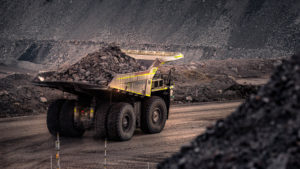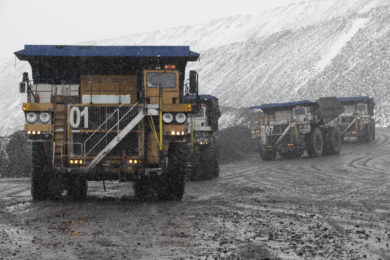Data driven insights are providing new possibilities to optimise the servicing of mining tyres, cutting downtime and costs, and improving safety. Mark Goode, Director for Business Insights at Kal Tire’s Mining Tire Group, recently presented some interesting study results in a white paper in which he also makes the case for leaning on the data.
Goode states: “Tyre management is a critical part of safe, productive mining operations. Effective service strategies not only maximise mining tyre performance by reducing the risk of failures and extending their useful life but, through optimising the frequency and nature of tyre service work, mines can potentially lower their operating costs, increase workforce safety and improve their overall efficiency.”
Traditionally, he says mining tyre service strategies have centred on maximising tyre life. “This not only speaks to the cost of tyres and the desire for each operation to get the most from its assets, but also the way in which the tyre industry is structured. Tyre manufacturers usually base the performance of their products (and compare them to competitors) on a cost-per-hour basis, and so this is a metric that mines, and tyre distributors, have tended to focus on. However, times are changing. Recent years have seen a degree of disintermediation in tyre supply and many mines are now opting to purchase tyres directly from manufacturers. This has shifted the industry dynamics and has meant that some tire distributors are now placing a greater emphasis on the service elements of their businesses. This is a good thing for mining companies, because it means they can (if they wish) examine and optimise their tyre service strategy independent from their supply strategy.”
Although Goode argues that the two will always be inherently linked, he says optimising them separately provides potential opportunities to redefine success in each area, widening the scope to better reflect each site’s priorities and objectives. “Further to this, there is important consideration to be given to operational safety. Safe production is always a higher priority than production in and of itself. The ability to measure and value safety allows it to be accounted for and embedded into maintenance activities, demonstrating greater responsibility towards the workforce.”
Looking beyond tyre life
Goode adds that tyre manufacturers are primarily interested in maximising the life of their tyres, while mines are primarily focused on productivity. “Extending tyre life is generally good for productivity, but it’s not always the case. There are several other things to bear in mind.”
While tyre service providers can have a significant impact on tyre performance, there are other factors that may play a more fundamental part in determining ultimate tire performance. Operational decisions, for instance, in haul road maintenance or pit design, the experience of truck operators, climatic conditions and the choice and quality of tyre, also play their part. Likewise, commodity cycles have a big influence; production strategies driven by the price of the commodity and the availability (or scarcity) of mining tyres both impact on how tires are treated. There’s a fine balance to be struck between production and the maximisation of tire performance, and the former is often detrimental to the latter.
“Typically, ultra-large mining tyres are removed from service either because they fail, or they’re deemed unsafe to continue due to damage,” said Goode. “Approximately 90% never get to worn out, and there’s a clear correlation between the price of commodities and tyre life: when prices are high, mines focus on productivity at the cost of tyres and, when prices are low, there’s a greater emphasis on cost cutting and protecting assets through activities like repairs.”
Whatever the focus from a tyre management aspect, there are certain activities that service providers typically incorporate, such as tyre rotations. These are critical not only from a safety point of view, but also in maintaining a sufficient inventory of spares. Additionally, tyre performance can be extended through repairs and retreading. However, all these activities require downtime and that comes at a cost. “When mines agree on a tire management strategy with their service provider, it’s important that they consider what success will look like,” said Goode. “They should determine whether they would like to maximise performance or productivity. Most operations want both, but that’s difficult to achieve.”
The true cost of tyre service work
Downtime for both planned and unplanned tire service work can have big impacts, both directly, through operational costs, and indirectly through potentially unnecessary additional downtime events. “Downtime can affect utilisation, and utilisation can affect productivity. While mines have always understood this, it’s only in the past five years that tyre service providers have developed the tools to provide greater visibility on the cost of downtime associated with tyre servicing. New generation tyre management software linked to the mine plan mean that it’s now possible to accurately calculate the cost of downtime associated with tyre service activities. This is critical because, for many mines, profit margins are gradually eroding as resource grades deplete and the cost-per-ton of material moved increases. In short, mines need to plan their maintenance activities as efficiently as possible, including their tyre-related service work. “Most tyre-related management systems are optimised to measure how long tyres last given the operating conditions,” explained Goode.
“They don’t track, for example, how many times a tyre is changed during its life or put a cost to each of those events, which we can do now. The introduction of Kal Tire’s Tire & Operations Management System (TOMS) in 2016, means that we can now tell mines how much it costs them in availability every year to service their tyres. That information is powerful in identifying opportunities for improvements.”
Optimising tyre servicing
The ability to put a value on downtime means that information can be used to create a tyre service strategy which is optimised for each site in any given time period. The strategy that each mine chooses and the priorities it’s based upon will drive the number of downtime events for tyre work and how often trucks are brought out of service. And, just as a business’ objectives evolve over time in response to market conditions, so too should the site’s tyre service strategy. “As an industry, we’re not great at planning tyre maintenance work,” said Goode. “Today, we often have the data required to optimise that work, but most mines struggle to utilise it.”
He adds: “For example, if a mine has a fleet of 100 trucks, and there are 500 tyre service jobs that need to be completed per year, there will be months when the same truck is brought down multiple times for service work and only one job completed per event. There are mines where the cost of downtime runs to thousands of dollars per hour, so the cost of those extra downtime events can very quickly add up.”
Tyre service work is a maintenance activity & should be treated & optimised in the same way as any other maintenance activity

Planning and optimising service intervals to coincide with other work on the truck – for instance, planned mechanical services – not only makes good sense from a financial perspective, because it minimises downtime, but there’s also a safety benefit. “A site that’s bringing trucks down more often will be placing greater stress on its tyre crew than one that’s able to aggregate its service work and have fewer downtime events. Unplanned work, for instance, when a tyre is run to the point of failure, could also mean that service crews must be dispatched into the pit.”
This places them at greater risk of harm and should be avoided wherever possible. “Tyre service work is a maintenance activity, and it should be treated and optimised in the same way as any other maintenance activity on site,” added Goode. “From a business perspective, this is low hanging fruit; mining companies always have one eye on improving their operational efficiency, and here is an element that can be optimised relatively quickly and easily using the tools that are available today.”
Real sites, real potential
Kal Tire uses aggregated and anonymised datasets from TOMS to benchmark performance between the sites it services, and it’s worked with several customers to prove how effective tyre service optimisation can potentially be. “Let’s look at the numbers from two real sites,” said Goode. “We’ll call them site A and site B. Both sites were running 57 in haulage truck tyres. Site A focused its service strategy on reducing the number of times it bought trucks out of service for tire work. It planned, aggregated and scheduled the work more effectively than site B, which focused its strategy on maximising tyre performance.”
“Site A changed its tyres an average 4.3 times during their lifetime, while site B changed its tyres just over 6 times, and we can quantify the impacts of that difference in service work. The extra service time at site B generated a 13% year-on-year increase in tyre performance and saved the mine US$500,000 in new tyre spend. But its technicians were exposed to potential safety hazards for 41% more time than at site A. Meanwhile, site A saw a 5% year-on-year decrease in tire performance. However, based on reasonable estimates of downtime costs, the additional utilisation created by optimising service work was worth up to US$10 million. That’s a significant value add opportunity and improvement in safety through reduced exposure hours.”
This example illustrates that the ‘what’ and ‘when’ of tire service work matters; combined with effective planning and scheduling, it can add more value under certain circumstances than focusing on tire performance alone. The ability to review the impact of tire service strategy on tire performance and operational safety allows mines to quantify the impacts of their choices, ultimately allowing them to make more informed decisions.
Power to the people
In summary, Goode says it’s not usually possible to maximise both tyre performance and utilisation; one will nearly always come at the expense of the other. “However, using the management systems and insights available today, mines can strike an acceptable balance between the two, which allows them to meet both their safety and financial goals. Importantly, the ability to model and quantify these impacts allows teams to build a solid business case which supports their decisions. The availability of this data also helps to promote more unified ways of working.” For instance, the ability to demonstrate the impact of changes in service decisions on both tyre budgets and downtime costs can help to manage the differing priorities of maintenance and production teams. “The most important thing in tyre strategy is to choose one,” said Goode. “For some mines, tyre performance may be the priority while, for others, fleet productivity will be king; there’s no right or wrong answer. Either way, the tools we have today ensure that once a decision is made, we can monitor and adjust the strategy to drive the most amount of value for each site, whatever the circumstances.”










